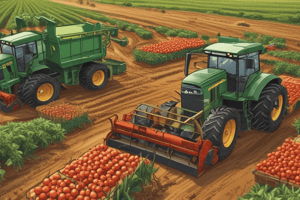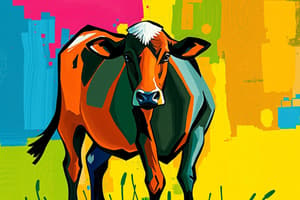Podcast
Questions and Answers
Match the following agricultural products with their primary production regions:
Match the following agricultural products with their primary production regions:
Rice = Asia Corn = North America Wheat = Europe Soybeans = South America
Match the following agricultural practices with their descriptions:
Match the following agricultural practices with their descriptions:
Crop rotation = Method of planting different crops in a regular sequence Grazing = Allowing livestock to feed on natural pasture Irrigation = Supplying water to land or crops to help growth Agroforestry = Integrating trees and shrubs into farming systems
Match the following agricultural issues with their impacts:
Match the following agricultural issues with their impacts:
Soil erosion = Reduction in soil fertility and productivity Pesticide overuse = Harmful effects on non-target organisms and ecosystems Water scarcity = Limitation of crop growth and agricultural activities Climate change = Alteration of growing seasons and weather patterns
Match the following agricultural economics concepts with their definitions:
Match the following agricultural economics concepts with their definitions:
Match the following agricultural economics policies with their objectives:
Match the following agricultural economics policies with their objectives:
Match the following agricultural economics indicators with their meanings:
Match the following agricultural economics indicators with their meanings:
Flashcards are hidden until you start studying
Study Notes
Matching Agricultural Products and Production Regions
- Agricultural products are grown or raised in specific regions due to factors like climate, soil, and resources.
- This matching exercise requires knowledge of global agricultural production patterns.
- For example, coffee is primarily produced in South America, while wheat is grown in various regions including North America and Europe.
Matching Agricultural Practices and Descriptions
- Agricultural practices are the methods used in farming, including planting, harvesting, and managing crops and livestock.
- Descriptions can include details about the techniques, tools, or resources used.
- For example, organic farming involves using natural fertilizers and pest control methods, while precision agriculture uses technology to optimize crop yields and resource use.
Matching Agricultural Issues and Impacts
- Agricultural issues are challenges that arise in farming, such as climate change, soil degradation, and pest infestations.
- Understanding the impacts of these issues is crucial for developing solutions.
- Climate change can affect crop yields and livestock health, while deforestation contributes to soil erosion and biodiversity loss.
Matching Agricultural Economics Concepts and Definitions
- Agricultural economics studies how resources are allocated and utilized in the agricultural sector.
- It focuses on understanding the factors influencing production, consumption, and trade of agricultural products.
- Key concepts include supply and demand, market equilibrium, and agricultural policy.
Matching Agricultural Economics Policies and Objectives
- Agricultural policies are government interventions aimed at influencing the agricultural sector.
- These policies can have different objectives, such as supporting farm income, ensuring food security, or promoting sustainable practices.
- For example, price supports are designed to guarantee minimum prices for farmers, while subsidies can encourage the adoption of specific technologies.
Matching Agricultural Economics Indicators and Meanings
- Agricultural economics indicators provide insights into the state of the agricultural sector.
- These indicators measure aspects like production levels, prices, and trade volumes.
- Understanding the meaning of these indicators helps in analyzing trends and making informed decisions.
- For example, crop yield measures the amount of harvested crop per unit area, while the consumer price index reflects changes in the cost of food for consumers.
Studying That Suits You
Use AI to generate personalized quizzes and flashcards to suit your learning preferences.




